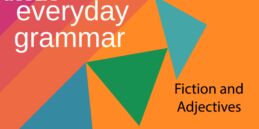正文
小说,形容词短语和形容词从句
Are you thinking of ways to pass the time and improve your English? In our electronic age, an old-fashioned kind of activity might be just what you need.
Reading fiction is a great way to learn and explore new worlds.
Today we will discuss one of the most important ways that writers use grammar to express images and ideas: different kinds of adjectives.
We begin with some definitions.

Adjectives
Nora Bacon is an English professor at the University of Nebraska Omaha. She has written about language, grammar and writing for several publications.
Bacon also wrote a book, called "The Well-Crafted Sentence." In it, she notes that one of the biggest differences between spoken and written English is the use of ‘adjectivals:' adjectives, adjective phrases, and adjective clauses. They are much more common in writing than in speaking, she notes.
As many of you know, adjectives are words that add meaning to nouns. Consider this example.
Toni Morrison was a writer.
This statement does not have an adjective. It is a very simple, factual statement.
Here is how an adjective could change the sentence:
Toni Morrison was a great writer.
The adjective great adds meaning to the noun, writer.
This statement gives information about the speaker or writer's opinion of Morrison.
Here is an important thing to remember about adjectives. Adjectives do not agree with the nouns they go with; they are neither singular nor plural. A final "s" is never added to an adjective, notes Betty Azar, a grammar expert we have noted in other Everyday Grammar programs.
Here is an example that shows what she means:
Ernest Hemingway and F. Scott Fitzgerald were great writers.
Note that the noun writers is plural. But the adjective great is the same as in our sentence about Toni Morrison.
Adjective phrases
Sometimes, adjectives appear as phrases - groups of words.
These adjective phrases can be part of the noun phrase, or they can come before or after it. Let me give you an example. Imagine you are reading a horror story:
A thick, dark, oppressive fog covered the city.
A fog, thick, dark, and oppressive, covered the city.
Thick, dark, and oppressive, the fog covered the city.
Writers often use these kinds of phrases to establish or develop a kind of feeling, or mood, in their story.
Adjective clauses
Adjective clauses, also called relative clauses, are groups of words that have a subject-verb pair.
Some words, such as that, which, or who, often lead into adjective clauses. Think back to our example about the fog. Here is how it might change if it had an adjective clause.
The fog that covered the city was dark and thick.
In general, the adjective clause comes after the noun that it is describing.
Adjective clauses often answer questions like "What kind of?" or "Which one?"
Sometimes writers leave out words such as that or who. With time, you will begin to recognize when these words do not appear.
If you would like to learn more about words that disappear from relative clauses, read The Mystery of the Disappearing That.
You can find it on our website www.hxen.net ,.
An example from Amy Tan
Let us turn to another example, this one from My Grandmother's Choice by writer Amy Tan. Tan describes an old picture she rediscovered. She wrote the following words:
"The dark-jacketed woman next to her is a servant..."
The term dark-jacketed acts like an adjective and describes the noun, woman. But something might be missing...
Let's think about the example again, with one small change:
"The dark-jacketed woman (who is) next to her is a servant..."
The adjective clause is who is next to her is a servant. The words who is do not appear.
Closing thoughts
You have now learned about all kinds of adjectives. These adjective structures are one of the most important tools that writers use to bring their stories to life.
The next time you are reading a book – science fiction, mystery, romance – try to find examples of adjectives, adjective phrases, and adjective clauses.
Over time, you will begin to understand how writers develop their special, unique, and wonderful styles.
And that's Everyday Grammar.
I'm Ashley Thompson.
And I'm John Russell.
John Russell wrote this story for Learning English. George Grow was the editor.




 手机网站
手机网站